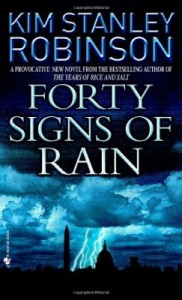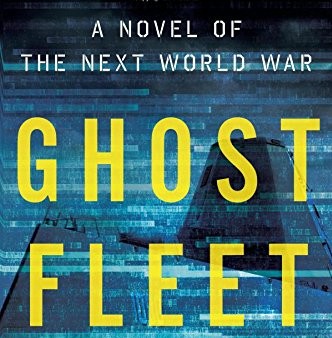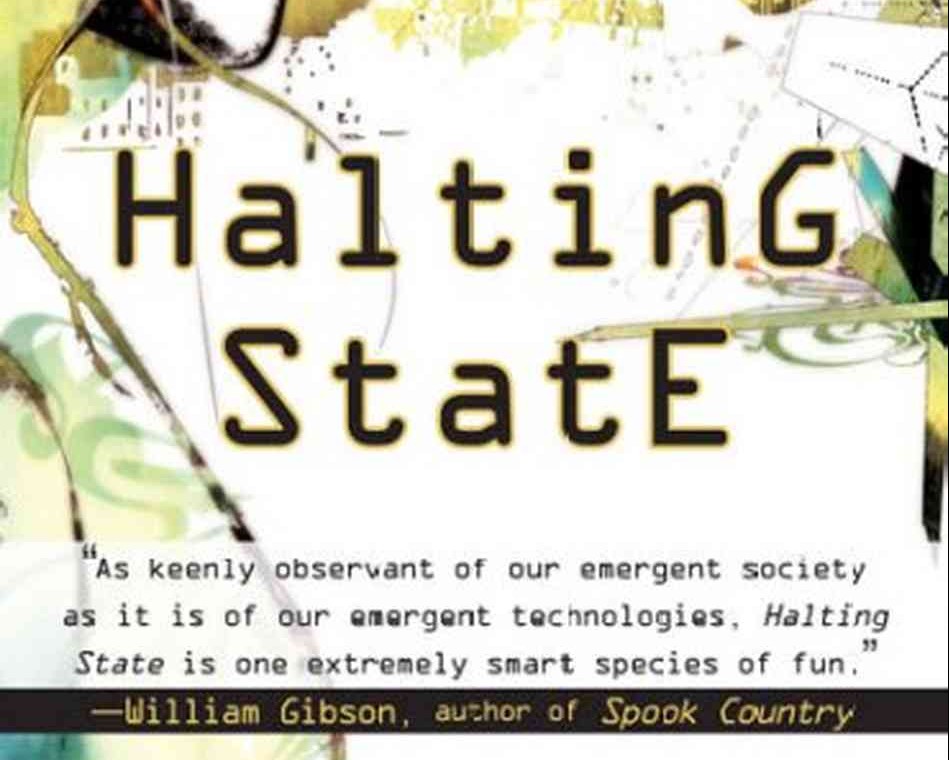The science fiction in Forty Signs of Rain is subtle, permeating the book through little snippets such as wrist-mounted screens and small technological improvements to the devices we already have. This is a very far cry from the omnipresent enhanced reality of Charles Stross’ books or any other number of interpretations of how technology will change our future.
In fact, this is a book about the intersect between global warming and politics, or perhaps the lack of an intersect where one ought to be. It’s near future setting looks forward to a gradually worsening environment, rather than new technological marvels.
We are presented with the problem of global warming from the point of view of individuals who do not need to be convinced of the truth of its impact, who can understand and even to a certain extent predict both the timing and the consequences of what a shift in climate is going to do to the world, but who find themselves powerless to do anything about it despite their position as some of the most influential individuals in the field, in the most powerful country in the world.
Without pointing a finger at it, naming it or bemoaning it directly, political apathy and institutionalised immobility are omnipresent in the book, seen through the eyes of people who are seeking, each in their own way, to advance an agenda that will lead to a change in environmental policy. Their efforts are real and tangible, their eventual impact less so.
The main characters include senior scientists at the National Science Foundation, both a director and a visionary scientist on a temporary assignment in her organisation. Also the director’s husband, who is science advisor to an influential senator and devoted to passing a bill, sponsored by his senator, that represents a big step in the direction of reduced emissions and other measures to mitigate climate change.
Instead of presenting their efforts as a mission or a quest, each has exposure to the environmental issues as a core part of their job. Their knowledge and conscience lead them to seek change in the context of their daily work, and they are motivated by their own personal belief systems. In this the book is very realistic – change is effected by individuals such as these, not often by crusading heroes tearing down old paradigms. Unfortunately, their collective effort is insufficient to cause any real change in policy or on the environment. In the real world, they would undoubtedly fail also, how could they not, given the vastness of what they must achieve to have even the most subtle impact.
So as we see them each apply pressure to the system in their own way, we also see the deteriorating environment as a general backdrop to the novel. Catastrophic changes in salinity and sea temperature are mere pages away from meetings with the president’s chief scientist in which it becomes obvious that no amount of statistics, reason or argument will move the policy needle. I was strangely reminded of the resistance to gun control during this scene in which logic was happily brushed to one side in favour of doubt, votes and the avoidance of cost. The country, as embodied by its leaders, finds it easier to ignore the problem than deal with it.
Woven into the story are small hints at things greater than ourselves most obviously in some interesting interactions between main characters and some Tibetan monks who are the catalyst to major changes in the way a scientist, Frank, perceives his role and the role of science in the world. This provides Robinson with the opportunity to theorise how it is not cold science alone that will change things, because it takes energy and passion to overcome societal inertia.
As the environment gradually slips into catastrophe and sea levels rise inexorably, the discussion continues, and the book culminates with a flood in Washington DC, the monuments surrounded by water, the zoo animals running wild, and a sense, more or less unspoken, that even this will not be enough to instigate any meaningful change.
I found the book a little depressing in that our main characters are revealed to be somewhat impotent in the conflict they are a part of. This is contrary to what we often seek in a story – we want the protagonist to overcome the obstacles and demonstrate strength while being changed for the better by the effort of reaching his goals. Perhaps to a certain extent this is true of Frank, but the goals seem unattainable.
The typical heroic narrative is abandoned here perhaps to serve the larger goal of getting a message across. This eminently readable book is holding up a mirror, and perhaps a few people will look long enough and with eyes open enough to see a reflection of society that they didn’t expect. I have no problem believing that the events portrayed are totally realistic and even likely to occur, and that we will soon be facing exactly the problems described, and that we will have done no better than the fictional nations in Forty Signs of Rain to compensate for a warming climate, rising oceans and more violent weather by the time these phenomena are too advanced to address with preventative measures. As a message, this book works well, and I hope it is widely read, although if it is right in its diagnosis of the root of our apathy and denial, it won’t make a difference, because perhaps nothing can.







